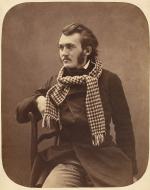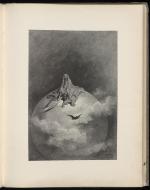Created by Owen Kleis on Thu, 02/29/2024 - 11:14
Description:
Gustave Doré (1832-83) is a French illustrator noted for his exceptional depictions of famous works, including, but not limited to, Dante's Divine Comedy, Milton's Paradise Lost, Cervantes's Don Quixote, and The Bible. His work spans from 1854 to his death, and it is notable that, though a French illustrator, the majority of his illustrations are for British and American works. Though he trained as an engraver, the majority of his illustrative works (especially later projects) were engraved by outside artists. Born in Strasbourg, Doré showed great talent at the early age of 5, and he spent his childhood and early teenage years engraving famous French works. Later, he earned a commission for a complete a set of illustrations for Lord Byron's poetic musings, and this began his career as an illustrator. Doré's illustrations are notable in that they tackle grim and sublime scenes from famous literature in a way that is moreso dramatic than realistic. He plays with lightness and darkness, effectively evoking visceral emotions from scenes already drenched in heavenly suffering. His Divine Comedy work is perhaps the most famous of his illustrative outputs and has become exemplary of both Doré's artistic style and the Comedy's dark and powerful story. While most of his work is Biblical, he has also illustrated smaller works, such as the poetry of Edgar Allan Poe and Coleridge. Doré died at the age of 51 with no spouse or children, though his lengthy catalogue of work has proven to stand the test of time.
Gustave Doré, Photographed by Nadar, c.1856, courtesy of Wikipedia. This photograph, taken by renowned photographer Gaspard-Félix Tournachon (known colloquially as Nadar), shows Doré as he was: dramatic, brooding, and solitary. While other portraits of Doré attempt to depict him in a professional and serious light, this picture seems to show another side of the illustrator. He wears a bold scarf and turns away from the camera, directly showing a flair for the artistic that hints at his highly detailed work to follow. Taken in the middle of his career, this photograph only adds to the renowned legacy that Doré would soon become known for.
Gustave Doré, "Dante in the Gloomy Wood," The Divine Comedy: The Inferno, Engraved by Ausnand, 1861, courtesy of The Victorian Web. The opening illustration to Doré's Divine Comedy, this image shows a weary Dante at the beginning of his journey. Dante is alone in the woods, and this differs from other Comedy illustrators who attempt to show the scene in which Dante is faced with three beasts in the opening scene of Inferno. Doré doesn't try to overload this illustration with haunting imagery, but rather lets the scene speak for itself. The twisting trees and minor use of light make the forest appear perhaps more frightening than it would initially seem, and Dante's backwards turn allows the viewer to feel a connection with the traveler before his upcoming journey to the underworld. The forest is overgrown and larger than Dante, but the illumination around Dante hints at the heavenly light he will eventually encounter in Paradiso.
Gustave Doré, "Now Night Her Course Began," Paradise Lost, Engraved by Adolphe Ligny, 1886, courtesy of Falvey Library, Villanova University. This intensely detailed engraving shows how illustrative and powerful Doré's work can be. Once again playing with sunlight and darkness, this image provides a stark contrast between the glorious sun and pensive Satan. A characteristic of Doré's work is his limited use of scenery, and this illustration demonstrates that a cliff, some clouds, and a central figure can be intensely evocative. Satan's wings are spread across the illustration, and he appears not so much terrifying (as we have come to expect from drawings of Satan) as he does contemplative. There is an unexpected humanity about the figure, and because of this, Doré is able to expand on Milton's characterization of the angel in a way that both adds to the text and allows the viewer to feel a sort of sympathy for the devil.
Gustave Doré, "Doubting, Dreaming Dreams No Mortal Dared to Dream Before," Facsimile from The Raven by Edgar Allan Poe (Harper Brothers), Engraved by F.S. King, 1884, courtesy of The Library of Congress. Though not as famous as other illustrations, this scene from Poe's "The Raven" is one of the darker and more haunting works of Doré's career. The raven, shown in flight towards the bottom of the image, is not the central feature of this work, as the illustrator wants to focus on the horror elements of the poem. Death, complete with a scythe and billowing cloak, foregrounds the piece, sitting atop an earthly sphere. Though Poe's poem does not explicitly connect this line to Death, Doré understands this scene as one where the menacing creature looks directly at the reader/viewer. Unlike the previous two illustrations, there is not much use of light here, except for the sprinkling of stars above Death's body, and this lack of light makes the atmosphere of the illustration that much more frightening to behold.
Sources consulted:
https://victorianweb.org/art/illustration/dore/index.html





